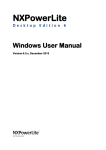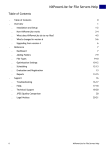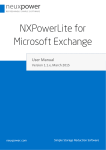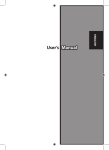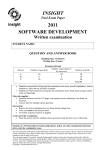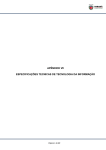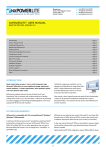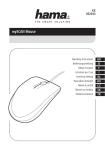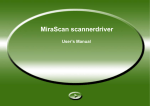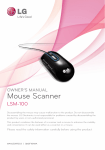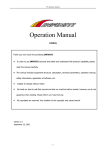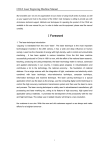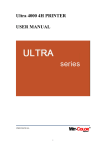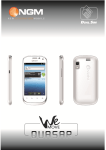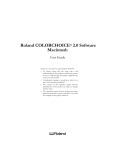Download User Manual - Pillar Solutions Ltd
Transcript
User Manual
Version 5.0, January 2011
Introduction, System Requirements
Introduction
NXPowerLite Desktop Edition radically reduces the size of Word documents, Excel®
spreadsheets, PowerPoint® presentations, PDF documents and JPEG images. They remain
in their original format, with no discernible loss of quality - and there's no need to unzip
before using them.
It's incredibly easy to use. Simply select
a file, choose your compression level and
click the 'Optimize' button.
If you use Lotus® Notes®, Microsoft®
Outlook®, Outlook® Express or Windows®
Mail, NXPowerLite Desktop Edition will
automatically optimize email attachments
as they are sent.
System Requirements
NXPowerLite Desktop Edition is compatible with PCs running Microsoft® Windows® 2000 or
later. Microsoft® Office integration requires Office 2002-2010 (32-bit). NXPowerLite does not
require Microsoft® Office or Adobe® Acrobat® to be installed, although better results will be
achieved with some Word files if Microsoft® Word is installed.
2.
File Types Optimized
Supported Email Clients
Microsoft® Word (97-2010) Microsoft® Excel® (97-2010) Microsoft® PowerPoint® (97-2010)
PDF
JPEG
Standard ZIP archives containing the above
Lotus® Notes® (6.0-8.5)
Microsoft® Outlook® (2002-2010 32-bit)
Microsoft® Outlook® Express (6.0+)
Microsoft® Windows® Mail (6.0+ 32-bit OS)
Initially, the NXPowerLite Desktop Edition installer will ask you to choose your setup type.
The options are 'Typical', 'Custom', or 'Complete'.
If you choose 'Typical' or 'Complete',
NXPowerLite will be installed, along with
add-ins that integrate NXPowerLite with
Windows® Explorer, Microsoft® Office and
supported email clients. If you choose
'Custom', you'll be given the option to
choose which add-ins are installed.
Explorer integration will enable you
to optimize a file by right-clicking it in
Windows® Explorer and selecting 'Optimize
with NXPowerLite...'.
Email client integration will enable you to
automatically optimize email attachments as
they are sent (see 'Email Client Integration').
To uninstall NXPowerLite, select it from the
'Add/Remove programs' list in Windows®
Control Panel.
Installation, Registration
Installation
NOTE: There are additional bulk deployment
options which allow amentments to
NXPowerLite's default email integration
behavior. Please see the 'NXPowerLite
Deployment Guide' document for details.
Word, Excel® or PowerPoint® integration
will enable you to optimize a file by selecting
'Optimize with NXPowerLite...' from the
application's 'File' menu (Office 2000-2003)
or 'Add-Ins' tab (Office 2007-2010).
Registration
When you first start NXPowerLite Desktop Edition, it will open in 'Evaluation Mode'. This
mode is designed for people that want to test NXPowerLite before buying the software. You
can use NXPowerLite for 30 days in Evaluation Mode. After 30 days, you'll need to enter your
25-character registration code to continue using NXPowerLite.
To enter your registration code, either
click on the 'Enter Code...' button that
appears at the bottom of the NXPowerLite
'About' screen, or select 'Enter registration
code...' from NXPowerLite's 'Help' menu.
A window will appear containing boxes for
you to enter your name and code.
You should have received your registration
code when you purchased NXPowerLite
(it's usually sent via email).
If you didn't receive a code, or if you've lost
it, there is a 'Registration Reminder' tool
available at www.neuxpower.com/support.
3.
Getting Started
Getting started
The main NXPowerLite Desktop Edition window looks like this:
To optimize a file, either drag it onto the
window or select it using the 'Add Files..'
button. You can select all Word, Excel®,
PowerPoint®, PDF, JPEG or ZIP files within a
folder by clicking the 'Add Folder...' button.
If a ZIP file is selected, NXPowerLite will
optimize any Word, Excel®, PowerPoint®,
PDF or JPEG files within it. Please note
that NXPowerLite can only open standard/
legacy ZIP archives.
To remove a file from the list, select the file
and either hit the 'Delete' key or click the
'Remove' button.
Next, choose an optimization level.
4.
The default option, 'Screen', is suitable for
most purposes. Files will look great on
screen, but may not be suitable for high
quality printing.
'Print' can be used if high quality printouts
are required. Files will be print-quality, but
file sizes will be slightly larger.
'Mobile device' can be used if files only
need to be viewed on cellphones or PDAs.
File sizes will be tiny, but picture quality
may be poor on larger screens.
Once you've chosen an optimization level,
click the 'Optimize' button to optimize your
files.
Custom optimization settings enable you to fine-tune NXPowerLite Desktop Edition's
performance. When 'Custom' is selected in the main NXPowerLite window, the 'Settings'
button becomes active. Clicking this button opens the 'Settings' window. Once custom
settings have been set, NXpowerLite will remember them if you select another profile. When
you re-select 'Custom', the most recently used custom settings will be displayed.
Image Optimization tab
In this tab, you can view the settings for
each pre-set optimization profile and
amend custom settings. Each profile's
settings can be viewed by selecting it in the
profile drop-down list. Custom settings can
be viewed and edited by selecting 'Custom'
in the profile drop-down list.
and 'Mobile device' default settings
have changed from previous versions of
NXPowerLite ('Screen' has changed from
1024x768 to 1600x1200 and 'Mobile device
has changed from 480x480 to 800x600),
which will result in improved visual quality
but slightly larger file sizes).
'Resize images' enables NXPowerLite to
resize large images to a more appropriate
size (please note that this setting is now
disabled by default, a change from previous
versions of NXPowerLite, which will result
in improved visual quality but slightly
larger file sizes).
Adjusting 'JPEG quality' will affect the
size of your files, but also the quality of
JPEG images. Higher quality will generally
result in a larger file size, but better looking
pictures. The default setting of '7' ('8' for
JPEG files) offers the best trade-off between
file size and quality (please note that the
default settings have changed from '6' in
previous versions of NXPowerLite, which
will result in improved visual quality but
slightly larger file sizes).
The 'Resize for display at:' drop-down
list allows you to select the target screen
resolution that you expect your files to be
viewed at (please note that the 'Screen'
Custom Optimization Settings
Custom Optimization Settings
5.
Custom Optimization Settings
Dots Per Inch (DPI)
NXPowerLite does not include dots per inch (DPI) settings. Please use the information
below to match a target screen resolution to your preferred DPI.
320 x 240 = 40dpi
480 x 480 = 60dpi
640 x 480 = 80dpi
800 x 600 = 100dpi*
1024 x 768 = 128dpi
1280 x 1024 = 160dpi
1440 x 900 = 180dpi
1680 x 1050 = 210 dpi
1600 x 1200 = 200dpi**
1920 x 1200 = 320dpi
* = 'Mobile device' default
** = 'Screen'/'Print' default
Hidden Content Tab
It is possible to gain some further reductions
in file size by removing hidden data from
files. NXPowerLite can remove different
types of data depending on the file type.
Microsoft® Office: image cropping
'Allow
image
cropping'
enables
NXPowerLite to remove any portions of
images that have been cropped within
Word, Excel® or PowerPoint® files.
Microsoft® Office: Flatten embedded objects
Embedded documents are items created
by another application that have been
embedded within a document, spreadsheet
or presentation. If NXPowerLite Desktop
Edition finds embedded documents within
your Word, Excel® or PowerPoint® files, it
will ask whether you want to flatten them.
For example, if you paste an Excel® chart
into PowerPoint®, the Excel® chart is
embedded within your presentation.
6.
Double-clicking on an embedded document
will allow you to edit it with the application
in which it was created.
NXPowerLite is able to flatten embedded
documents by converting them into
pictures.
Flattening embedded documents
will
reduce the size of your files considerably,
but the embedded documents will no
longer be editable.
Checking the 'Don't ask me this question
again'
box will prevent NXPowerLite
from asking you whether you want to
flatten embedded documents in future.
NXPowerLite will remember whether you
selected 'Yes' or 'No' and use this as the
default setting. You can change the default
setting at any time by selecting 'Settings'
from NXPowerLite's 'Tools' menu and
clicking on the 'Hidden Content' tab.
NXPowerLite is able to remove this data
while leaving a valid PDF file and without
compromising the visual quality of the file.
Some editing features may be disabled,
but often the PDF file can still be edited
in Illustrator or Photoshop since those
applications can read PDF natively.
In most cases, we recommend enabling this
option as it is likely to produce substantial
size reductions in some PDF files.
Checking the 'Don't ask me this question
again'
box will prevent NXPowerLite
from asking you whether you want to
delete private application data in future.
NXPowerLite will remember whether you
selected 'Yes' or 'No' and use this as the
default setting. You can change the default
setting at any time by selecting 'Settings'
from NXPowerLite's 'Tools' menu and
clicking on the 'Hidden Content' tab.
Custom Optimization Settings
PDF: Delete private application data
PDF editing applications such as Adobe
Acrobat,
InDesign,
Illustrator
and
Photoshop can store editing information
inside a PDF file which can considerably
increase the file size.
Optimized Files Tab
By default, NXPowerLite will save an
optimized file in the same folder as the
original and add '(NXPowerLite)' to the
optimized file's name. You can change
this behavior by selecting 'Settings' from
NXPowerLite's 'Tools' menu and clicking
on the 'Optimized Files' tab, or by clicking
the 'Edit' button in the 'Settings' area of the
main NXPowerLite window.
If you'd prefer to save your optimized files in
a different folder, select 'Single folder'.
The address bar and 'Browse...' button will
then become active. Type the new folder
path or click the 'Browse..' button and
browse to the folder.
Check the 'Save optimized file with same
name as original' box if you'd like to keep
the original file name.
Clicking the 'Naming...' button opens the
'Optimized File Naming' window:
7.
Custom Optimization Settings
8.
In this window, you can edit the text that
is automatically added to the names of
your optimized files. You can also choose
whether the text appears at the beginning
or end of the file name.
Additionally, you can chose to 'preserve
original file's date and time'. If you select
this option, your optimized files will have
the same date and time information as the
originals, rather than the date and time that
the originals were optimized.
When NXPowerLite Desktop Edition has finished optimizing your files, you'll be shown a
summary of the results, including the reduction in file size that has been acheived:
A green tick in the right-hand
column means that a file was optimized successfully.
A
red
cross
in
the
right-hand column means
NXPowerLite was unable to
optimize the file (usually
because it was already fully
optimized, or because it
contained no graphics or
hidden data). It may also mean
that an error occurred. For
additional information, rightclick a file and select 'Details',
or double-click the icon.
Two blue arrows forming a
circle means that the file is
currently being processed. The
icon will change to a green
tick or a red cross when the file
has been processed.
The 'Results' Window
The 'Results' Window
From the 'Results' window, you can 'Open',
'Email' or 'Zip & Email' the selected file (or
files) by clicking the appropriate button
(hold down the 'Shift' or 'Control' key to
select multiple files).
If you select 'Open', the optimized file will
be opened in your default application.
If you select 'Email', the optimized file will
be attached to a blank email in your default
email client.
If you select 'Zip & Email', the optimized file
will be zipped and attached to a blank email
in your default email client.
Right-clicking a file in the 'Results' window
will enable you to perform any of these
actions on either the optimized or the
original file. Additionally, you can choose
to view details on, or delete the optimized/
original file.
9.
Email Client Integration
Email Client Integration
NXPowerLite Desktop Edition integrates with email clients to automatically optimize
email attachments as they are sent. Currently supported email clients are Lotus® Notes®,
Microsoft® Outlook®, Outlook® Express and Windows® Mail.
Lotus® Notes® Integration (Notes® 6.0-8.5)
If you installed NXPowerLite with a
'Typical' or 'Complete' setup (or ticked the
'Notes® Integration' box during a 'Custom'
setup), Lotus® Notes® integration will be
initially enabled.
If you don't want NXPowerLite to
optimize an attachment, select 'Disable
NXPowerLite' from Notes®'s 'Actions' menu.
Optimization will remain disabled until you
re-enable NXPowerLite.
Whenever you send an email with an
attachment that NXPowerLite can optimize,
it will be automatically optimized as the
email is sent.
Microsoft® Outlook® Integration (Outlook® 2002-2003)
If you installed NXPowerLite with a 'Typical'
or 'Complete' setup (or ticked the 'Outlook®
Integration' box during a 'Custom' setup),
Microsoft® Outlook® integration will be
initially enabled.
Whenever you send an email with an
attachment that NXPowerLite can optimize,
it will be automatically optimized as the
email is sent.
10.
If you don't want NXPowerLite to optimize
an attachment, click Outlook®'s 'Optimize
Attachments' button to disable the feature.
Optimization will remain disabled for
any new emails until you re-enable
NXPowerLite by clicking the 'Optimize
Attachments' button again. Once enabled,
it will remain enabled for all new emails
until disabled.
Email Client Integration
Microsoft® Outlook® Integration (Outlook® 2007-2010 32-bit)
If you installed NXPowerLite with a 'Typical'
or 'Complete' setup (or ticked the 'Outlook®
Integration' box during a 'Custom' setup),
Microsoft® Outlook® integration will be
initially enabled.
Whenever you send an email with an
attachment that NXPowerLite can optimize,
it will be automatically optimized as the
email is sent.
If you don't want NXPowerLite to optimize
an attachment, click Outlook®'s 'Optimize
Attachments' button to disable the feature.
Optimization will remain disabled for
any new emails until you re-enable
NXPowerLite by clicking the 'Optimize
Attachments' button again. Once enabled,
it will remain enabled for all new emails
until disabled.
11.
Email Client Integration
Microsoft® Outlook® Express / Windows® Mail Integration (OE / Mail 6.0)
If you installed NXPowerLite with a 'Typical'
or 'Complete' setup (or ticked the 'Outlook®
Express Integration' box during a 'Custom'
setup), Microsoft® Outlook® Express
integration (Windows® XP) or Windows®
Mail integration (Windows® Vista® or later,
32-bit) will be enabled.
Whenever you send an email with an
attachment that NXPowerLite can optimize,
it will be automatically optimized as the
email is sent.
12.
If you don't want NXPowerLite to optimize
an attachment, click the 'Optimize
Attachments' button to disable the feature.
Optimization will remain disabled for
any new emails until you re-enable
NXPowerLite by clicking the 'Optimize
Attachments' button again. Once enabled,
it will remain enabled for all new emails
until disabled.
In any of the above email clients, selecting
'NXPowerLite Settings...' will open the
On the 'Attachments' tab, you can choose
which file types to automatically optimize
(unchecking all boxes will disable
attachment optimization). You can also
set the minimum file size to optimize and
choose whether to re-optimize files that
have already been optimized.
'NXPowerLite Settings' window:
Email Client Integration
Email Client Settings (all supported email clients)
On the 'Image Optimization' tab, you can
choose your optimization settings (see
'Custom Optimization Settings' ).
On the 'Hidden Content' tab, you can choose
whether to flatten embedded documents (see
'Custom Optimization Settings').
13.
14.
15.
For further information, technical support or sales enquires, please contact:
NXPowerLite is a Trademark of Neuxpower Solutions Ltd.
Microsoft, Excel, Outlook, PowerPoint and Windows are Registered Trademarks of Microsoft Corporation.
Lotus Notes is a Registered Trademark of IBM Corporation.
© 2001-2011 Neuxpower Solutions Ltd. All rights Reserved.


















